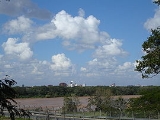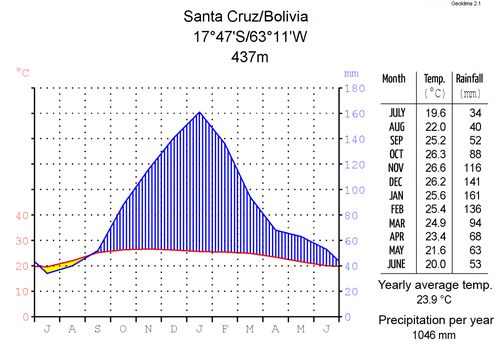
Andrés Ibáñez Province
Encyclopedia
Andrés Ibáñez Province is one of the fifteen provinces of the Bolivia
n Santa Cruz Department
, situated in the western part of the department. Its capital is Santa Cruz de la Sierra
which is also the capital of the department.
The province was created on December 6, 1944, during the presidency of Gualberto Villarroel López.
and between 62° 48' and 63° 40' West
. It extends over 110 km from west to east, and 90 km from north to south.
The province is situated in the Bolivian lowlands and borders Ignacio Warnes Province
and Sara Province
in the north, Ichilo Province
in the northwest, Florida Province
in the southwest, Cordillera Province
in the southeast, and Chiquitos Province
in the east.
 Andrés Ibáñez Province is situated in an area of a semihumid
Andrés Ibáñez Province is situated in an area of a semihumid
tropical
climate. It is characterized by a very short dry season
in the months of July and August and sufficient precipitation
during the rest of the year, reaching a maximum in January.
The monthly average temperatures are a tropical 20 to 26°C, with the lowest temperatures in the dry season when nights are slightly colder because the cloud cover is broken. The yearly average temperature is 23.9°C.
which are further subdivided into cantons
.
40.1 % of the population are younger than 15 years old. (1992)
99.0 % of the population speak Spanish
, 12.5 % speak Quechua, 3.4 % Aymara
, and 0.8 speak Guaraní
. (1992)
6.7 % of the employed population work in agriculture
, 1.0 % in mining
, 14.1 % in the industrial sector
, and 78.2 % in general services (2001).
15.7 % of the population have no access to electricity, 22.2 % have no sanitary facilities. (1992)
86.1 % of the population are Catholics, 9.7 % are Protestants. (1992)
Bolivia
Bolivia officially known as Plurinational State of Bolivia , is a landlocked country in central South America. It is the poorest country in South America...
n Santa Cruz Department
Santa Cruz Department
Santa Cruz, with an area of 370,621 km², is the largest of the nine constituent departments of Bolivia. In the 2001 census, it reported a population of 2,029,471. The capital is the city of Santa Cruz de la Sierra. The state is one of the wealthiest states in Bolivia with huge reserves of...
, situated in the western part of the department. Its capital is Santa Cruz de la Sierra
Santa Cruz de la Sierra
Santa Cruz de la Sierra, commonly known as Santa Cruz, is the capital of the Santa Cruz department in eastern Bolivia and the largest city in the country...
which is also the capital of the department.
The province was created on December 6, 1944, during the presidency of Gualberto Villarroel López.
Location
Andrés Ibáñez Province is located between 17° 30' and 18° 15' SouthLatitude
In geography, the latitude of a location on the Earth is the angular distance of that location south or north of the Equator. The latitude is an angle, and is usually measured in degrees . The equator has a latitude of 0°, the North pole has a latitude of 90° north , and the South pole has a...
and between 62° 48' and 63° 40' West
Longitude
Longitude is a geographic coordinate that specifies the east-west position of a point on the Earth's surface. It is an angular measurement, usually expressed in degrees, minutes and seconds, and denoted by the Greek letter lambda ....
. It extends over 110 km from west to east, and 90 km from north to south.
The province is situated in the Bolivian lowlands and borders Ignacio Warnes Province
Ignacio Warnes Province
Ignacio Warnes is one of the fifteen provinces of the Bolivian Santa Cruz Department and is situated in the department's central parts. The province name honors Colonel Ignacio Warnes , a military leader in the South American war of independence....
and Sara Province
Sara Province
Sara is a province in the Santa Cruz Department, Bolivia. Its capital is Portachuelo.- Subdivision :The province is divided into three municipalities which are further subdivided into cantons....
in the north, Ichilo Province
Ichilo Province
Ichilo is one of the fifteen provinces of the Bolivian Santa Cruz Department and is situated in the department's north-western parts. The province was founded by a decree of 8 April 1926 and is named after Río Ichilo which is forming the province border in the West.- Location :Ignacio Warnes...
in the northwest, Florida Province
Florida Province
Florida is a province in the Santa Cruz Department, Bolivia. Its capital is Samaipata. The province was created by law on December 15, 1924.-Division:The province is divided into four municipalities which are further subdivided into cantons....
in the southwest, Cordillera Province
Cordillera Province (Bolivia)
Cordillera is a province in the Santa Cruz Department, Bolivia. Its capital is Lagunillas.- Geography :This area of the Santa Cruz Chaco occupies the southern part of the department, is the largest province of the country, geographically defined as the Gran Chaco and that extends to the departments...
in the southeast, and Chiquitos Province
Chiquitos Province
Chiquitanía is a region of tropical savannas in the Santa Cruz Department in eastern Bolivia."Chiquitos" is the colonial name for what is now essentially five of the six provinces that make up the Chiquitania, a region in Bolivia's Santa Cruz department. "Chiquitos" refers to a region, not a tribe...
in the east.
Climate

Humidity
Humidity is a term for the amount of water vapor in the air, and can refer to any one of several measurements of humidity. Formally, humid air is not "moist air" but a mixture of water vapor and other constituents of air, and humidity is defined in terms of the water content of this mixture,...
tropical
Tropics
The tropics is a region of the Earth surrounding the Equator. It is limited in latitude by the Tropic of Cancer in the northern hemisphere at approximately N and the Tropic of Capricorn in the southern hemisphere at S; these latitudes correspond to the axial tilt of the Earth...
climate. It is characterized by a very short dry season
Dry season
The dry season is a term commonly used when describing the weather in the tropics. The weather in the tropics is dominated by the tropical rain belt, which oscillates from the northern to the southern tropics over the course of the year...
in the months of July and August and sufficient precipitation
Precipitation (meteorology)
In meteorology, precipitation In meteorology, precipitation In meteorology, precipitation (also known as one of the classes of hydrometeors, which are atmospheric water phenomena is any product of the condensation of atmospheric water vapor that falls under gravity. The main forms of precipitation...
during the rest of the year, reaching a maximum in January.
The monthly average temperatures are a tropical 20 to 26°C, with the lowest temperatures in the dry season when nights are slightly colder because the cloud cover is broken. The yearly average temperature is 23.9°C.
Division
Andrés Ibáñez Province comprises five municipalitiesMunicipalities of Bolivia
Municipalities in Bolivia are administrative divisions of the entire national territory governed by local elections. Municipalities are the third level of administrative divisions, below departments and provinces. Some of the provinces consist of only one municipality...
which are further subdivided into cantons
Cantons of Bolivia
||On the level below municipalities, Bolivia is divided into cantons ....
.
| Section | Municipality | Inhabitants (2001) | Seat |
|---|---|---|---|
| Capital Municipality | Santa Cruz Municipality | 1,135,526 | Santa Cruz de la Sierra Santa Cruz de la Sierra Santa Cruz de la Sierra, commonly known as Santa Cruz, is the capital of the Santa Cruz department in eastern Bolivia and the largest city in the country... |
| 1st | Cotoca Municipality | 36,425 | Cotoca Cotoca Cotoca is a town in Bolivia. In 2010 it had an estimated population of 23,951.-References:Cotoca is about 20 Kilometers away from the city of Santa Cruz, Bolivia... |
| 2nd | Ayacucho Municipality or Porongo Municipality | 11,085 | Porongo |
| 3rd | La Guardia Municipality | 39,552 | La Guardia La Guardia, Bolivia La Guardia is a town of 50,000 in the Santa Cruz Department of . It is the 16th most populous town in the country.-Web links:*... |
| 4th | El Torno Municipality | 37,961 | El Torno |
Population
The population of Andrés Ibáñez Province has increased by circa 130 % over the recent two decades:- 1992: 784,678 inhabitants (censusCensusA census is the procedure of systematically acquiring and recording information about the members of a given population. It is a regularly occurring and official count of a particular population. The term is used mostly in connection with national population and housing censuses; other common...
) - 2001: 1,260,549 inhabitants (censusCensusA census is the procedure of systematically acquiring and recording information about the members of a given population. It is a regularly occurring and official count of a particular population. The term is used mostly in connection with national population and housing censuses; other common...
) - 2005: 1,526,187 inhabitants (est.)
- 2010: 1,841,282 inhabitants (est.)
40.1 % of the population are younger than 15 years old. (1992)
99.0 % of the population speak Spanish
Spanish language
Spanish , also known as Castilian , is a Romance language in the Ibero-Romance group that evolved from several languages and dialects in central-northern Iberia around the 9th century and gradually spread with the expansion of the Kingdom of Castile into central and southern Iberia during the...
, 12.5 % speak Quechua, 3.4 % Aymara
Aymara language
Aymara is an Aymaran language spoken by the Aymara people of the Andes. It is one of only a handful of Native American languages with over three million speakers. Aymara, along with Quechua and Spanish, is an official language of Peru and Bolivia...
, and 0.8 speak Guaraní
Guaraní language
Guaraní, specifically the primary variety known as Paraguayan Guaraní , is an indigenous language of South America that belongs to the Tupí–Guaraní subfamily of the Tupian languages. It is one of the official languages of Paraguay , where it is spoken by the majority of the population, and half of...
. (1992)
6.7 % of the employed population work in agriculture
Agriculture
Agriculture is the cultivation of animals, plants, fungi and other life forms for food, fiber, and other products used to sustain life. Agriculture was the key implement in the rise of sedentary human civilization, whereby farming of domesticated species created food surpluses that nurtured the...
, 1.0 % in mining
Mining
Mining is the extraction of valuable minerals or other geological materials from the earth, from an ore body, vein or seam. The term also includes the removal of soil. Materials recovered by mining include base metals, precious metals, iron, uranium, coal, diamonds, limestone, oil shale, rock...
, 14.1 % in the industrial sector
Industry
Industry refers to the production of an economic good or service within an economy.-Industrial sectors:There are four key industrial economic sectors: the primary sector, largely raw material extraction industries such as mining and farming; the secondary sector, involving refining, construction,...
, and 78.2 % in general services (2001).
15.7 % of the population have no access to electricity, 22.2 % have no sanitary facilities. (1992)
86.1 % of the population are Catholics, 9.7 % are Protestants. (1992)

